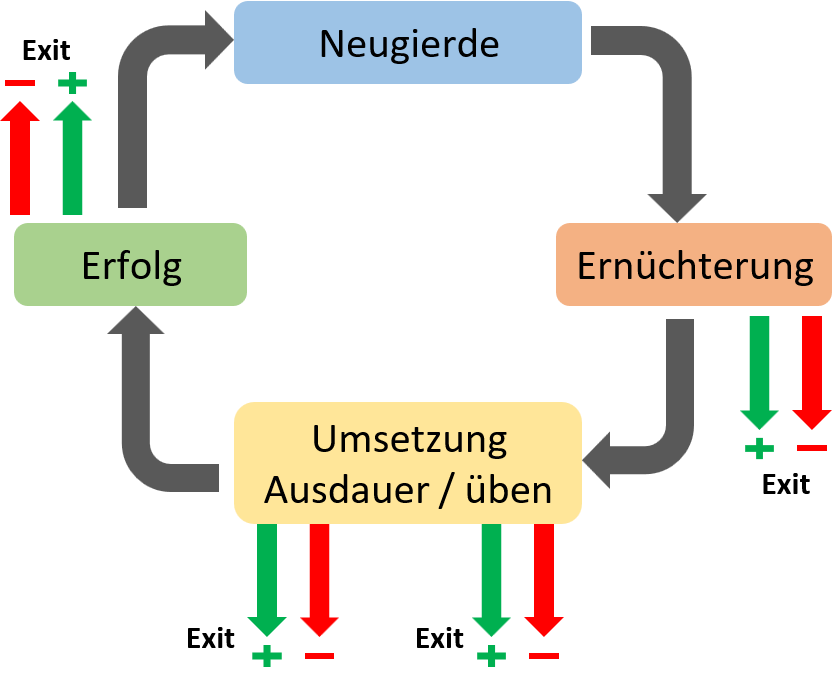Success Loop
From idea to success. The Success Loop shows you the way!
Success Loop
The Success Loop describes the path from an idea to achieving a set goal.
During your Success Loop, you might reach a point where you abandon your project. Reasons for giving up can be both negative and positive. Positive exit options are "healthy" reasons for leaving that do not create feelings of loss (e.g., focusing on something else that is more important at the moment). Negative exit options, on the other hand, result from personal patterns, negative emotions (e.g., defiance), or blockages.
The following sections illustrate the different phases of the Success Loop with their respective exit options using an example:

Curiosity
The process is initiated by curiosity about a topic or a specific goal.
Example: Thomas has always dreamed of obtaining a skydiving license because he has watched many videos about the extreme sport and believes it is perfect for him. Now he sets the skydiving license as a firm goal.
Disillusionment
After engaging with the subject a bit, the first real challenges become apparent. You develop an awareness that achieving the goal or implementing it will be more difficult or resource-intensive than originally thought.
Example: Thomas delves deeply into skydiving and the path to obtaining the license. He reads a lot and extensively informs himself about the content and requirements for obtaining the license. He realizes that more is needed for the exam and the (long-term) practice of skydiving than just courage: Preparing for the exam requires time for learning the theory and money for the mandatory jumps. Additionally, one needs expensive equipment in the medium term, must be physically and mentally fit, and it is advisable to be a member of an aviation club.
Negative exit option: Thomas has exam anxiety and convinces himself that he won't be able to pass the exam anyway.
Positive exit option: Thomas' girlfriend is expecting a child. Since obtaining the license and subsequently regularly practicing his hobby would take up a lot of time that he would rather spend with his child, he gives up his set goal.
Implementation
After the disillusionment phase, the implementation phase begins. Steps are initiated to achieve the set goal or realize the idea. In the implementation phase, there are two exit points. One is shortly after the start of implementation, and the other is before the end of implementation or in the midst of the implementation phase.
Start of Implementation
Thomas has booked his first weekend at the flight school. Here he learns the theory and completes his first (tandem) jump.
Negative exit option: Thomas quits because he convinces himself that he doesn't have what it takes to remember the theory topics.
Positive exit option: After his first jump, Thomas quits because he doesn't enjoy the sport as much as he hoped.
Before the End of Implementation
Thomas has already attended several courses where he has learned both the theory and participated in some jumps. He has already invested a lot of time and money.
Negative exit option: Thomas quits because he convinces himself that he has never finished anything before and therefore it won't work this time either.
Positive exit option: Thomas begins a professional retraining and decides to devote all his attention to it.
Success
In this phase, you "reap" what you have sown. The goal has been achieved, or the idea has been implemented. The exit here is only positive if the life goal has been reached and you rest on your laurels. Usually – hence the loop – you set a new goal afterward or have the next idea to realize and start the process anew.
Example: Success! Thomas has successfully passed his exams and obtained the skydiving license. He is proud of himself for not giving up and holding on to his dream. He has developed a liking for sports at high altitudes and has already found his next challenge: Free climbing.
Negative exit option: Thomas has achieved his goal. Due to negative thought patterns, he believes he doesn't deserve to achieve more.
Positive exit option: Thomas has achieved his goal. He wanted nothing more in life. He is perfectly happy and has no further goals or dreams.
